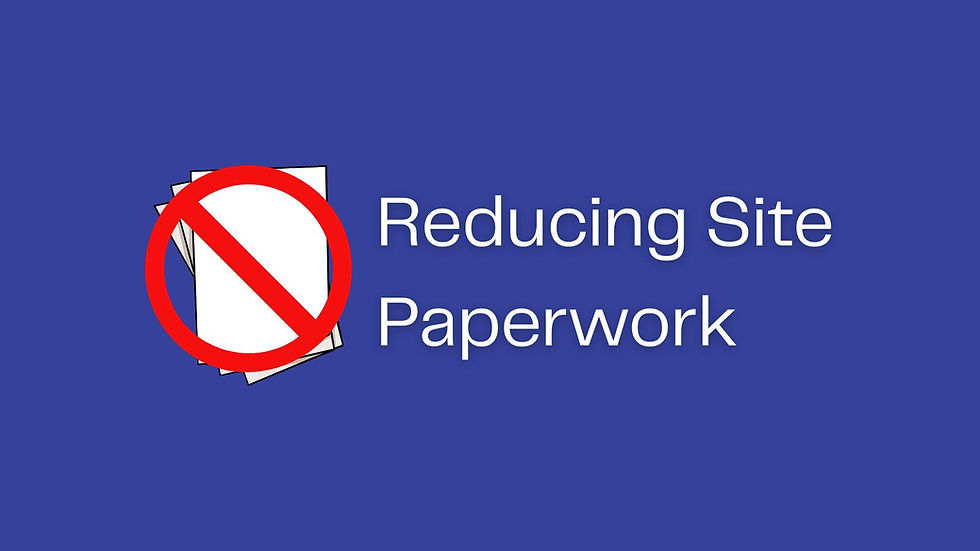No More Paper Timesheets: Why UK Construction Is Going Digital with Attendance Tracking
- richard51686
- Oct 23
- 7 min read
For decades, paper sign-in sheets have been the norm on construction sites, but this old habit is now hurting the industry. Recent insights show that around 60% of UK construction businesses still rely on paper-based attendance sheets, even though manual methods are prone to errors, “creative” entries, and buddy punching (one worker clocking in for another)[1]. The consequences? Companies often end up overpaying for hours that weren’t actually worked, chasing down lost or falsified timesheets, delaying payroll with manual data entry, and risking compliance breaches when accurate records can’t be produced[2]. One industry expert even described manual sign-in sheets as a “fraud factory” – with no reliable audit trail, it’s nearly impossible to ensure the records are truthful[3]. In short, sticking with paper makes it hard to trust your attendance data, which ultimately impacts budgets, efficiency, and legal compliance. And with profit margins in construction already thin, these hidden inefficiencies of paper can quietly erode the bottom line[4].
But times are changing. Under pressure from tighter margins and new safety regulations, UK construction firms are beginning to ditch paper and embrace digital attendance tracking solutions. Tools like TRAPPCO’s Attendance Module now provide real-time, precise records across all sites, eliminating guesswork and time fraud. In the sections below, we explore why moving away from paper timesheets is such a game-changer for construction companies, and the backstory of how this shift came about.
Accurate Hours and Fair Pay
Paper sheets often allow a bit of “fudging” – arriving late but writing down an earlier time, or co-workers signing in for someone who isn’t there. A digital system stops this by capturing exact timestamps (sometimes even with GPS validation), so workers are only paid for the hours they actually work[5]. Buddy punching becomes much harder when each person must log in with a unique ID or use their own device, meaning no one can quietly add a friend’s name. In fact, one UK survey found 16% of workers admitted to clocking in for a colleague at least once[6] – a form of time theft that digital tracking can virtually eliminate. By removing these loopholes, companies greatly reduce overpayments and payroll errors. Moreover, approved hours can flow directly into payroll software for faster, hassle-free processing[7]. The result is a fairer payroll for everyone: honest employees aren’t subsidizing those who cheat the clock, and management regains confidence that wage bills truly reflect work done.
Instant Visibility and the “Golden Thread”
One big advantage of digital attendance is instant visibility into who is on site, where, and when. Instead of waiting for weekly timesheets, managers and head office can see live attendance data across all projects. This creates what regulators call a “Golden Thread” of reliable workforce information that runs through a project[8]. The concept of a Golden Thread, highlighted in the UK’s Building Safety Act, means maintaining accurate, auditable records to improve safety and accountability. Replacing illegible sign-in sheets with a continuous digital log ensures you’re always audit-ready – whether it’s to prove labour law compliance or to verify that only certified workers were present for certain tasks. In fact, the latest building safety regulations require accurate, auditable workforce records, which digital systems are designed to deliver[9]. Essentially, digital attendance tracking turns a chaotic stack of paper into a clear story of who was on site, when, and where. This not only supports compliance and competency tracking, but also gives clients and regulators confidence that you have a firm handle on your workforce data[10].
Boosting Productivity On Site
Beyond just tracking hours, going digital with attendance can actually help boost productivity. How? By turning attendance data into actionable insights. Modern systems often include dashboards and reports that highlight patterns – for example, if certain crews or individuals are frequently late or have higher absence rates[11]. Unlike paper records that get filed away and ignored, digital data can be analyzed in real time. Managers can spot a developing issue and address it before it impacts the schedule. Perhaps you notice that a particular subcontractor’s team tends to start 15 minutes late every Monday – with data in hand, you can have a proactive conversation to fix that pattern. Curbing chronic lateness or absenteeism helps keep production on track and prevents small delays from snowballing into bigger project overruns. In short, digital attendance systems give you visibility into workforce productivity trends that simply isn’t possible when using paper. As TRAPPCO’s experience shows, turning attendance numbers into insights helps construction teams stay on schedule and improve overall efficiency[12].
Meeting Legal and Safety Requirements
For any construction company, keeping accurate attendance records isn’t just about efficiency – it’s also about legal compliance and safety. Digital time logs help ensure you meet UK labour laws and health & safety rules by documenting the exact hours each person works and their presence on site. This makes it much easier to demonstrate adherence to regulations like working time limits and required rest breaks[13]. If an inspector or client asks for proof of who worked on a particular day, you can produce a tidy digital report instead of shuffling through notebooks. Just as crucially, site safety benefits from real-time attendance tracking. In an emergency scenario (such as a fire or evacuation), a digital system can perform an instant roll-call to see who is on site and who might be missing, which can be lifesaving information for first responders[14][15]. By contrast, relying on a misplaced paper sign-in sheet during an emergency could lead to dangerous confusion. Maintaining accurate, accessible records of who is on site also supports overall safety planning – for example, ensuring that only authorized, inducted personnel are present, or quickly identifying if unqualified individuals entered a restricted zone. In summary, going digital with attendance gives construction firms greater control in staying compliant with H&S and labour laws, and it strengthens on-site safety by accounting for everyone in real time.
Cutting the Admin Burden (and Errors)
Anyone who has managed timesheets on a busy site knows how much administrative work they create. Collecting sheets from multiple sites, deciphering handwritten hours, chasing people who forget to sign out, and manually re-entering data into spreadsheets or payroll systems – it’s a huge time sink. By digitalising this process, all that clerical hassle virtually disappears. No more chasing missing paper or retyping data – attendance is captured once (when a worker clocks in/out on their phone or a site tablet) and is instantly available for payroll, reporting, or audits[16]. Managers and payroll staff no longer need to spend hours collating and correcting timesheets, freeing them to focus on core project tasks instead. This isn’t just about saving effort, it’s about avoiding mistakes, too: manual data entry is error-prone by nature. Eliminating paper removes multiple points where a wrong number or illegible scribble could slip through. There’s even a significant cost benefit. Studies have found that excessive paperwork can cost construction firms around £1,500 per employee per year in lost time and productivity[17]. By moving to a streamlined digital system, companies cut out this wasteful overhead. In short, less time on admin means lower operating costs and fewer costly errors – a win-win for the back office and the bottom line.
Affordable and Easy to Adopt
Digital attendance tools often use familiar devices like smartphones and QR codes, making them easy and affordable to implement on site. Many contractors initially worry that high-tech attendance systems will be expensive or complicated to set up. In the past, the go-to solution for tamper-proof time tracking was biometric hardware (fingerprint or facial scanners), which can be costly to install, require upkeep, and even raise privacy concerns[18]. Today, there are far more affordable alternatives. Modern digital attendance solutions – such as TRAPPCO’s module – leverage devices that workers already have, like smartphones or tablets, for check-ins[19]. For example, a site might use a simple QR code at the gate that workers scan with an app to clock in and out. This means no expensive gadgets or turnstiles are required; a basic tablet or the operative’s own phone can do the job. Because the software runs in the cloud, there’s minimal IT infrastructure needed and updates happen automatically. Training is straightforward as well, since the interfaces are designed to be user-friendly (often similar to common apps). In fact, as of today most construction workers carry a smartphone, so using one for time tracking feels natural. All these factors lower the barrier to adoption significantly. Even smaller contractors can implement digital attendance tracking without a huge upfront investment or disruption. The technology has matured to be accessible for any size company, not just the large players – making the move away from paper not only sensible, but truly feasible.
The Bottom Line: A Smart Move for Construction
Switching from paper sign-in sheets to a digital attendance module is more than just a tech upgrade – it’s a strategic move that saves time, money, and headaches. The UK construction industry has long struggled with razor-thin margins and increasing regulatory demands. In this context, accurate, real-time attendance tracking is no longer optional; it’s a business necessity that protects profit margins, ensures compliance, and builds trust with clients and regulators[20]. By embracing digital solutions, companies can eliminate the risks and inefficiencies of paper – no more “creative” clock-ins, no more missing timesheets, no more doubts about who was on site. The backstory to this shift is rooted in lessons learned from the past decade: from high-profile safety incidents highlighting the need for better records, to studies showing how much productivity is lost to outdated processes. The good news is that making the switch is easier than ever. With user-friendly options like TRAPPCO’s Attendance Module, even firms without big IT departments can quickly get up and running[21]. In the end, moving to digital attendance is about gaining control and transparency. It means paying your workforce only for the hours they work, staying on top of compliance, and having the data to improve your projects. In an industry where every hour and pound counts, ditching paper is a change whose time has come – and it’s propelling UK construction into a more efficient future.
Sources:
· TRAPPCO Ltd – Why UK Construction Is Moving from Paper Timesheets to Digital Attendance Tracking[22][3]
· Causeway Technologies – The Hidden Costs of Using Paper Timesheets[4]
[4] The hidden costs of using paper timesheets on construction sites




Comments